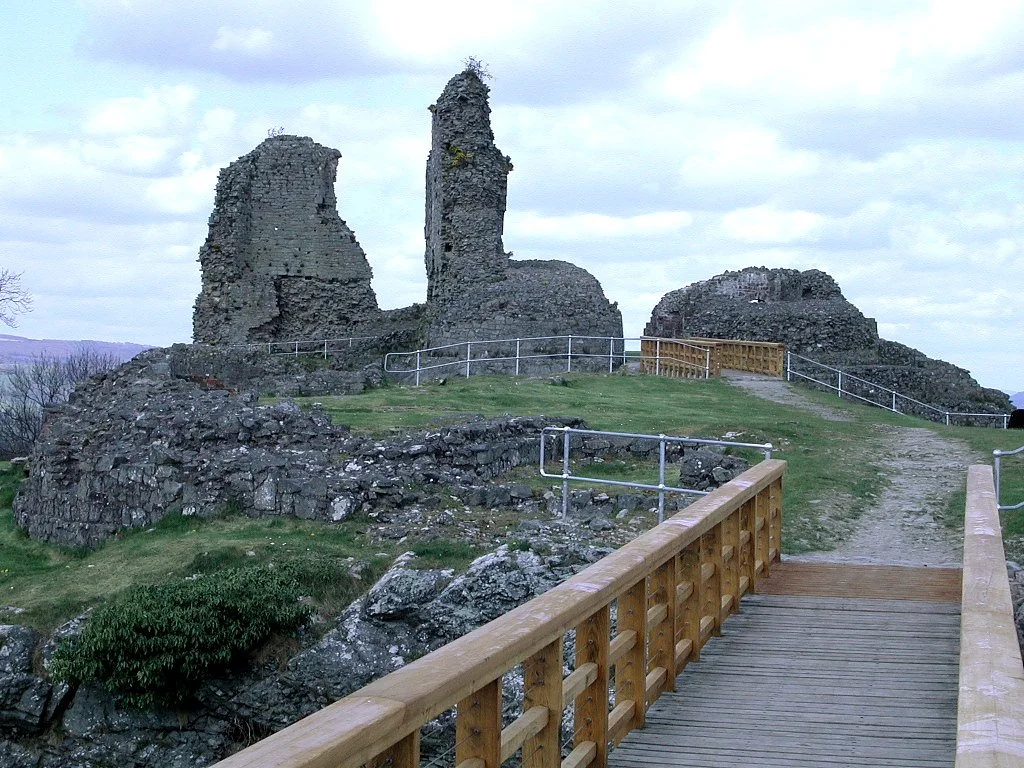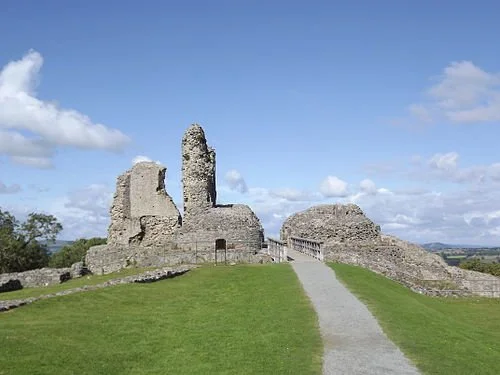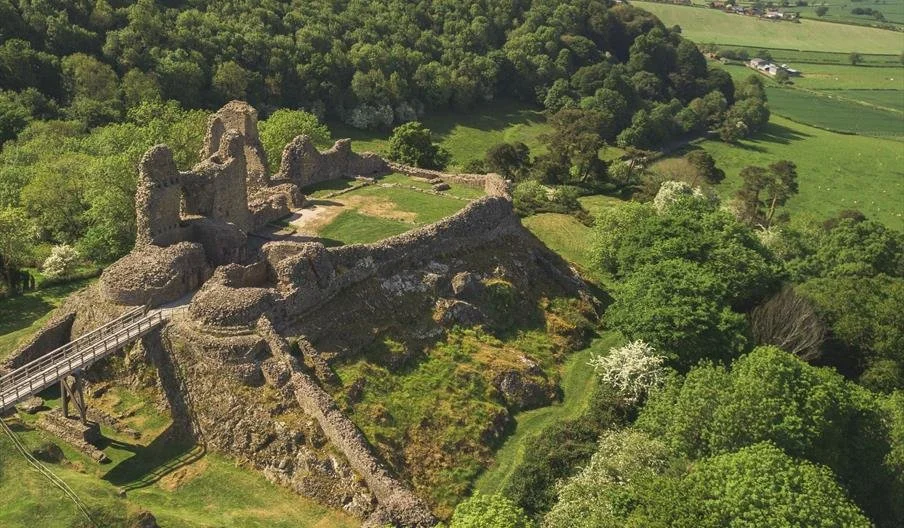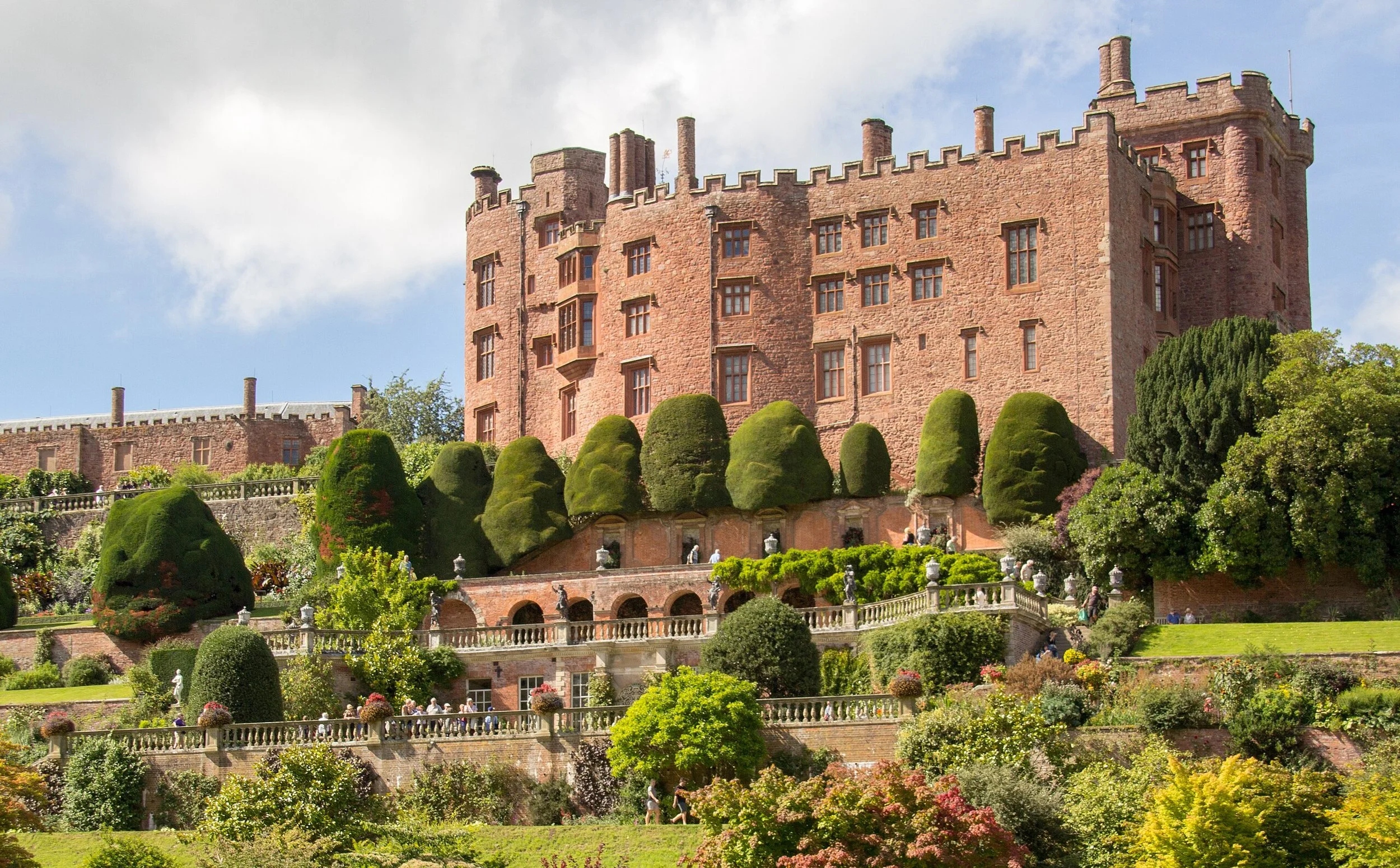Montgomery Castle | Visit Amazing Welsh Castles
Montgomery Castle is a ruined stone fortress in Powys, Wales. It stands above the market town of Montgomery. The castle offers clear views over the River Severn and the surrounding countryside.
Edward I built it during the late 13th century to secure English rule in the Welsh Marches. It replaced an earlier Norman motte-and-bailey structure nearby. Though ruined, the site remains an important symbol of medieval power struggles between Wales and England.
Quick Facts
Location: Montgomery, Powys, Wales
Type: Stone-built Marcher castle
Built: 1223 by Hubert de Burgh
Historical Use: Military stronghold, administrative centre
Current Condition: Ruins with surviving curtain walls and gatehouse remains
Entry Fee: Free public access (confirmed by Cadw)
Dog Friendly: Dogs allowed on leads
Managed By: Cadw (Welsh Government historic environment service)
What to See: Panoramic views, defensive structures, town walls, earthworks of an earlier motte-and-bailey
Brief History
The castle occupies a strategic hilltop high above the town, replacing an earlier motte-and-bailey known as Hen Domen, constructed around 1071–1074 by Roger de Montgomery. In 1093, it was seized by local Welsh princes and later granted to Baldwin de Boulers, whose name influenced the town’s Welsh name. However, in 1214 Prince Llywelyn ab Iorwerth destroyed the wooden fortress.
In late summer 1223, on Henry III’s sixteenth birthday, Hubert de Burgh began construction of a new stone castle a mile south-east of Hen Domen. Between 1223 and 1228, masons built an inner ward (or donjon) including a gatehouse, two D‑shaped towers and residential rooms around a curtain wall. After an unsuccessful Welsh attack in 1228, middle and outer wards were added, with further repairs following another assault in 1233 that damaged the well tower.
In 1227, the neighbouring town received a royal charter, and in 1267 it hosted negotiations for the Treaty of Montgomery, where Henry III recognised Llywelyn ap Gruffudd as Prince of Wales. Castle troops later participated in the 1282 campaign that led to the death of Llywelyn at Orewin Bridge.
In 1402, during Owain Glyndŵr’s revolt, the town was burnt but the castle held firm. The First English Civil War brought further change when Parliamentary forces captured the castle in September 1644. A subsequent Royalist attempt to retake it resulted in a significant clash. In June 1649, following the Second Civil War, walls were deliberately demolished to prevent future military use.
Today, it remains a ruin, with fragments of curtain walls, towers and earthworks providing insight into its layered history.
Images





Features and Layout
The castle reveals a three‑ward arrangement on a natural rocky promontory:
Outer defences include a deep rock‑cut ditch (circa 13.7 m wide, originally ~6.7 m deep) with an earthwork and barbican guarding the line of approach.
Middle ward sits beyond the outer ditch. Its gatehouse (1251–53) has twin round towers and a walled curtain, reflecting later stone reinforcement. Remains of a kiln house and 14th‑century masonry mark its evolution.
Inner ward crowns the site. It is fortified by solid curtain walls and a twin‑towered gatehouse built 1223–28, likely designed by Hubert de Burgh, with a well tower—D‑shaped—on the west housing a 64 m deep well.
Within the inner ward lay royal apartments, chapel, kitchen and brewhouse. Remaining sections of the kitchen and brewhouse walls still adjoin the curtain.
The well tower’s position over the cliff edge, built on the natural rock, led to repeated structural issues and a 14th‑century rebuild.
Drawbridges once spanned the raised ditches. The gatehouse incorporates defence features such as portcullis grooves, murder‑holes and dual timber doors.
The curtain walls vary in height: still tall on the western side, now much lower elsewhere .
Site context and layout
The castle perches on a ridge offering strategic views over the town, Severn valley and borders.
Accessed from the south via a path climbing through the defences, visitors today enter past the barbican to the middle and inner wards.
The site blends natural bedrock with built stonework—parts of the curtain wall and towers appear to ‘grow’ from the ridge.
Did You Know?
The well tower’s shaft reaches approximately 64 m down—a rarity for medieval castles, signifying the importance of securing water in siege conditions .
Visiting
The castle welcomes visitors year-round during daylight hours. You can arrive and explore with no need to book.
Opening Times (Cadw)
1 April–30 September: 10 am–6 pm
1 October–31 March: 10 am–4 pm
Last admission 30 minutes before closing
Closed: 24, 25, 26 December and 1 January
Admission: Free entry
Parking & Access
On-site parking for around 15 cars, including one disabled bay
A sloping, roughly 100 m path leads from the car park to the castle entrance
Facilities
No visitor centre or toilets on site
Nearby Montgomery town offers shops and public conveniences
Dog Policy
Dogs on leads are welcome
Directions
Castle Hill lies above Montgomery town. Follow signposts from the B4388, park in the designated lot, and walk the path to the castle.
Visitor Detail:
Look out for worn masons’ marks in the gate passage, carved by medieval stonemasons working on the twin-towered gatehouse.
Nearby Attractions
Here are some noteworthy places to visit nearby:
Powis Castle and Garden
A medieval fortress complemented by formal terraced gardens and grand 17th‑century interiors. It is Grade I listed and managed by the National Trust.
Old Bell Museum
A 16th‑century half‑timbered former inn, now restored as a local history museum run by volunteers from the Montgomery Civic Society.
Dolforwyn Castle
A scenic Cadw‑managed hilltop fortress from the 13th century, offering views across the Severn Valley.
Ffridd Faldwyn Iron Age Hillfort
One of the largest hill‑forts in Wales, located just above the town. Visitors can follow footpaths through wooded ramparts.
Montgomery Trails & Quiz Trails
Walking and cycling routes, plus family-friendly heritage quiz trails in the town centre.
The Checkers
A Michelin‑starred French/British restaurant (now “Checkers Pantry”), ideal for a refined lunch stop.
Montgomery Canal
A 33‑mile historic waterway popular for walks and wildlife spotting, designated a Site of Special Scientific Interest.
Visitor Tips
Wear comfortable footwear: paths are uneven and include a steep ascent.
Dogs are allowed on leads—bring waste bags as there are no on-site bins.
Early mornings are quieter, ideal for photography.
Download the Cadw app before visiting for historical context.
Visit Montgomery town for cafes, shops, and toilets after your castle tour.
Bring water in summer months; there are no refreshment facilities at the castle.
The castle is suitable for short visits (1–1.5 hours).
Look out for well-preserved mason’s marks in the gate passage.
FAQs
-
Montgomery Castle was built in 1223. It replaced an earlier Norman motte-and-bailey fortress called Hen Domen, built around 1071–1074. The current ruins reflect 13th and 14th century construction phases.
-
Yes, Montgomery Castle offers free public access year-round. It is managed by Cadw.
-
Dogs are welcome at Montgomery Castle. You must keep them on a lead at all times.
-
There are no facilities such as toilets or a visitor centre at the castle. Facilities are available in nearby Montgomery town, a short walk away.
-
Yes, there is a small car park below the castle hill with around 15 spaces, including one disabled bay.
Wrapping it Up
This castle offers a striking example of medieval military architecture. Built to control the Welsh Marches, it witnessed centuries of conflict and political negotiation. The surviving ruins include significant sections of curtain walls, towers, and defensive earthworks. Today, Montgomery Castle provides a peaceful location for short walks, historic exploration, and panoramic views across the Severn valley. With free entry, dog-friendly policies, and nearby attractions, it is a worthwhile visit for anyone exploring Powys.
Sources
Wikipedia
Provides history of the original motte-and-bailey (Hen Domen), site coordinates, stone castle construction 1223–1228 by Hubert de Burgh, attacks, Civil War events, and slighting in 1649.
montgomery-wales.uk+10Wikipedia+10Kiddle+10Castlefacts.info
Confirms the well tower’s shaft sinks to a depth of 64 m.
WikipediaWikipedia+8castlefacts.info+8gatehouse-gazetteer.info+8Gatehouse Gazetteer
Gives detailed layout description: ditch, ward divisions, inner gatehouse, brewhouse, kitchen layout, well tower structure, 64 m well depth. Wikipedia+3gatehouse-gazetteer.info+3castlefacts.info+3Cadw via Visit Mid Wales
Details opening times (1 April–30 September: 10 am–6 pm; 1 October–31 March: 10 am–4 pm), last admission 30 minutes before closing, free entry, no pre‑booking required, free parking, public transport info.
ratedtrips.com+3visitmidwales.co.uk+3visitmidwales.co.uk+3Crazyaboutcastles.com
Confirms free entry, parking close by, steep access path, and note that dogs are not allowed on site.
Castles, Forts, Chateaus+1mindtrip.ai+1Pinned on Places
Provides history of Hubert de Burgh, 1223 rebuild, 1228 Welsh attack, Civil War battle (September 1644), slighting 1649, and defensive layout with ditches.
Castles, Forts, Chateaus+9Pinned on Places+9Wikipedia+9Castle Wales
Describes surviving inner ward defenses, gatehouse rooms, masons’ marks, well tower and structural rebuild in 14th century, location of bakehouse and brewhouse.
Kiddle+8castlewales.com+8Pinned on Places+8




Aberystwyth Castle is a striking example of a coastal fortress built during the medieval period in Wales. It's found in the town of Aberystwyth, Ceredigion.